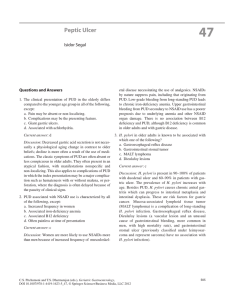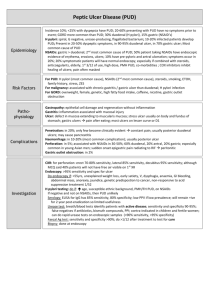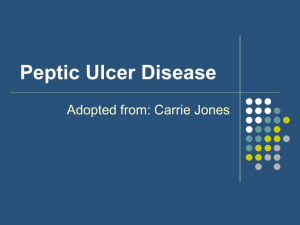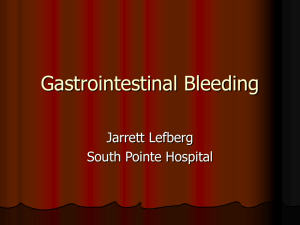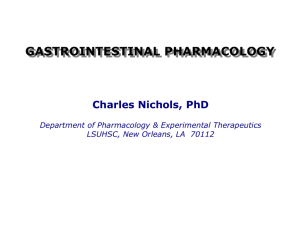Upper GI: Esophagus and Stomach
advertisement
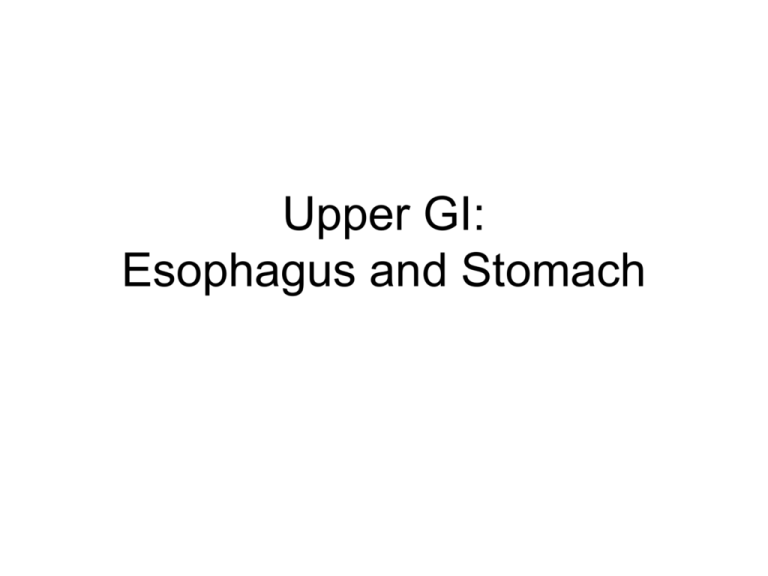
Upper GI: Esophagus and Stomach Dysphagia • Etiology – Obstructions • Intrinsic: tumors, strictures, herniations • Extrinsic: tumors, ascites, morbid obesity – Achalasia: LES dysfunction – Functional dysphagia: Neural problems • Clinical Manifestations – Discomfort with swallowing – Solids or liquids – Choking/aspiration Dysphagia • Evaluation – – – – History Barium swallow Manometry Endoscopy • Treatment – Behavioral – Dilatation/Surgery – Thickened diet Gastroesophageal Reflux Disease • Etiology – LES relaxation – LES defects – Delayed gastric emptying • Morphologic changes – Symptoms do not correlate to damage – No damage – Esophagitis • Sustained leads to Barret's esophagus • 10% of Barret's leads to esophageal cancer GERD • Clinical Manifestations – Heartburn – Regurgitation – Chest pain – Cough, sinusitis – Risk factors • Obesity • Acidic foods, Foods that relax LES GERD • Evaluation – Barium Swallow – pH study – Endoscopy • Treatment – Lifestyle changes – Acid lowering drugs – Motility enhancing agents – Surgery Pyloric Obstruction • Etiology – Congenital – Acquired • PUD • Duodenitis • Cancer • Manifestations – Fullness – Pain/distension – Projectile vomiting Pyloric Obstruction • Evaluation – Manifestations – Endoscopy • Treatment – Gastric suction – Treat PUD – Surgery – TPN Gastritis • Acute – Etiology • Helicobacter pylori • Drugs, esp NSAIDS – Manifestations • Vague abd pain • Tenderness Bleeding – Healing occurs spontaneously if conditions are removed • Chronic – Usually in older adults – Thinning and degeneration of stomach lining – Immune • Destruction of chief and parietal cells – Non-immune types • H. pylori • Hot liquids Gastritis • Manifestations – Vague – Discomfort with food – Bleeding • Treatment – Underlying conditions – Diet – Antibiotics Peptic Ulcer Disease (PUD) • Terminology – Superficial ulcers: erosions, no involvement of muscularis – True ulcers extend through muscularis; hemorrhage • Etiology – – – – NSAIDS H. pylori ETOH Stress PUD • Duodenal ulcers – most common • Manifestations – Pain begins 30 min - 2 hours after eating – Stomach is empty – Food-pain-relief – Bleeding – Remission-exacerbation PUD • Duodenal Ulcers – Evaluation • Barium swallow • Endoscopy • H. pylori detection – Treatment • lower acid • Treat H. pylori PUD • Gastric ulcers – Similar to duodenal ulcers – Usually chronic – Often associated with chronic gastritis – Sometimes associated with • Anorexia • Vomting • weightloss PUD • Stress ulcers – Acute peptic ulcers associated with severe illness or systemic trauma • Ischemic ulcers: post hemorrhage, burns, heart failure, sepsis, ventilation • Curling ulcers: from burns • Cushing ulcer: head trauma, brain surgery • Surgical treatment of Ulcers Post-Gastrectomy Syndrome • Dumping syndrome – Sudden gastric empyting – Decrease in blood volume – Manage with diet • • • • • Alkaline Reflux Gastritis Afferent loop obstruction Diarrhea Weightloss Anemia – Supplement Drugs for PUD, GERD PUD Risk Factors • • • • • Defensive factors Mucus Bicarbonate Blood flow Prostaglandins • • • • • • Offensive factors Helicobacter pylori NSAIDS Gastric acid Pepsin Smoking Overview of drug choices • Antibacterials • Antisecretory agents – H2 blockers – Proton Pump Inhibitors (PPIs) • Mucosal protectants – Sucralfate – Misoprostol • Antacids Antibacterials • • • • • H. pylori tests Breath test Blood test Stool test Biopsy test • • • • • • Antibiotics Bismuth Clarithromycin Amoxicillin Tetracycline Metronidazole H2 Blockers • • • • • Cimetidine (Tagamet) Ranitidine (Zantac) Famotidine (Pepcid) Nizatidine (Axid) Mechanism of action – H2 histamine receptors stimulate gastric acid secretion – Inhibition causes decreased gastric juices and decreased acid content H2 Blockers • Uses – Gastric and duodenal ulcers – GERD – Zollinger-Ellison Syndrome (gastrin secreting tumor) – Dyspepsia • Routes – Nizatidine can be given PO only – All others PO and IV H2 Blockers • Metabolism – Only cimetidine is metabolized by liver – Particularly: warfarin, phenytoin, theophylline, lidocaine • Adverse effects – Again, cimetidine is only one with significant – Antiandrogenic: gynecomastia, impotence, decreased libido – CNS: confusion, hallucinations, CNS depression or excitation • Moral: just say no to Cimetidine Proton Pump Inhibitors (PPI) • • • • • • Omeprazole (Prilosec) Lansoprazole (Prevacid) Rabeprazole (Aciphex) Pantoprazole (Protonix) Esomeprazole (Nexium) Mechanism – Inhibits hydronium-potassium pump – Prevents production of acid – All cause irreversible inhibition except lansoprazole PPIs • Uses – PUD – GERD – Prevention of ulcer with NSAIDs • Kinetics – PO: All; IV: pantoprazole, lansoprazole • Adverse effects – – – – Headaches Nausea Diarrhea Food poisoning? • Interactions – Only rabeprazole (digoxin) Sucralfate • Mechanism of action: forms a gel that adheres to ulcer and protects it • Kinetics: PO with minimal systemic absorption • Uses: Duodenal ulcer • Adverse effects: constipation • Interactions: antacids decrease action, impedes absorption of several other drugs Misoprostol • Mechanism of Action – Prostaglandin E1 analog – Stimulates mucus production – Reduces acid secretion – Maintenance of GI blood flow – Non GI: Induce termination; “ripen” cervix • Adverse effects: diarrhea, ABD pain, dysmenorrhea Antacids • Mechanism of Action – Alkaline substances neutralize acid – May stimulate prostaglandins • Uses – PUD – Dyspepsia (indigestion) – GERD (symptoms only; does not prevent Barrett’s esophagus) Antacids • Adverse Effects – Constipation and Diarrhea – Sodium loading – Check renal function before giving Mg containing antacids (CNS toxicity) • Interactions – Inhibits absorption of many drugs Magnesium hydroxide • • • • • Potent and long acting Solo: MOM Combo with AlOH common Causes diarrhea (often used as laxative) Avoid in patients with bowel obstruction or surgery • Check renal function Aluminum hydroxide • Weaker and slow acting • Causes constipation • Rarely used alone. Combine with MgOH – Maalox – Mylanta Calcium carbonate • • • • • Fast acting and potent Potential for rebound Calcium source Constipation Calcium Dioxide gas Vomit Reflex • Vomiting center – Cerebral cortex (fear, anxiety) – Sensory signals – Vestibular • Chemoceptor trigger zone (CTZ) – Stomach – Small intestine – Emetogenic substances • Antiemetics better at preventing than stopping Serotonin receptor antagonists (-setrons) • Uses – Most effective at preventing chemotherapy vomiting – Radiology – Surgery – PO or IV – Effects augmented by adding dexamethasone Serotonin receptor antagonists (-setrons) • Adverse effects – Headache, diarrhea, dizziness – Does not cause EPS • Agents – Ondansetron (Zofran) – Granisetron (Kytril) – Dolasetron (Anzemet) Dopamine Agonists • Phenothiazines – Promethazine (Phenergan) – Chlorpromazine (Compazine) • Butyrophenones – Haloperidol – Inapsine • Metoclopramide – Prokinetic Dronabinol (Marinol) • Nausea & vomiting associated with chemotherapy • AIDS • Adverse effects – Psychoactive: dysphoria, depersonalization, temporal dissociation – Hypotension, tachycardia • Abuse potential: Schedule III Other • Glucocorticoids – Not FDA approved • Usually used in cancer patients • Used in combination, esp with -setrons – Methylprednisolone (Solu-medrol) – Dexamethasone • Benzodiazepines – Not FDA approved – Lorazepam Motion Sickness Drugs • Anticholinergic – Scopolamine • Antihistamines – Dimenhydrinate (Dramamine) – Meclizine (Antivert) – Cyclizine (Marezine) • All work by making the patient drowsy – May increase risk of falls Salicylates • Sulfasalazine (sulfonamide) – Metabolized in intestine • 5-ASA • Sulfapyridine • Mesalamine – 5-ASA • Olslazine • Balsalazide Prokinetic • Metoclopramide – Actions • Suppresses emesis (blocks serotonin) • Increases upper GI motility (enhances ACH) – Uses • Nausea, Postop emesis, Gastroparesis, GERD – Adverse effects • Sedation, Diarrhea, EPS • Erythromycin – off label – (200mg QID, AC &HS)
